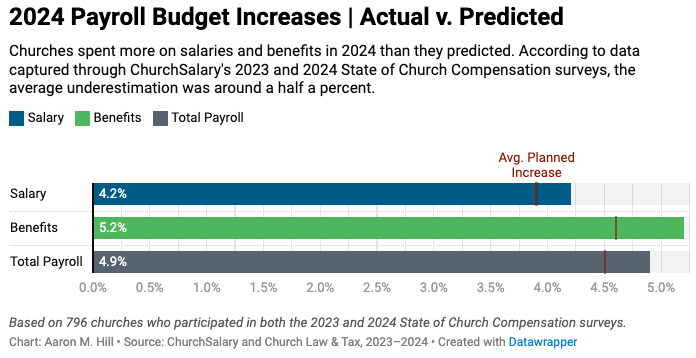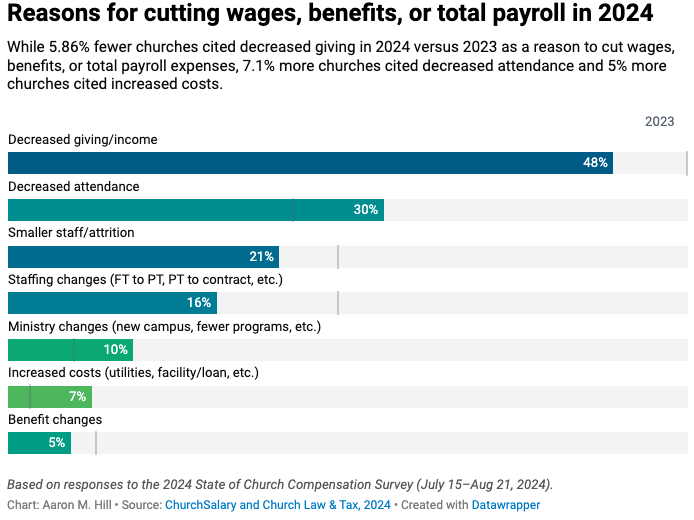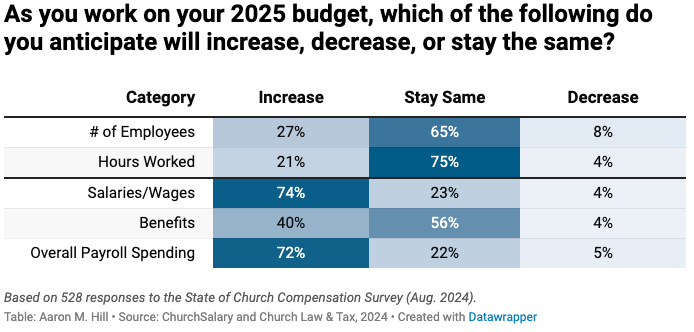Economic reality likely will frustrate the optimistic outlook many churches have about pay raises and staff growth next year, according to a new financial analysis of U.S. congregations.
“This fall, churches are extremely aligned on a cost-of-living adjustment for their 2025 budgets. At the same time, market forces are threatening to further shrink staff sizes or to force hard cuts to budgets for many churches,” ChurchSalary reported in its third-annual State of Church Compensation survey.
ChurchSalary was launched by Church Law & Tax in 2018 with funding from the Lilly Endowment. Its mission is to help pastors face the stress and obstacles of church finance.

The latest review of nearly 800 churches compared budget projections for 2024 with actual spending as of August and examined anticipated challenges and spending on payroll and benefits for the coming year.
In preparing budgets for the current year, churches planned to increase total personnel and payroll budgets by an average of 4.5%, which included merit raises, a roughly 3% cost-of-living adjustment and an increase in benefits and hiring.
“At a more detailed level, last year’s respondents planned to spend an additional 3.9% on salaries, 4.25% for benefits and 4.2% for total personnel/payroll in 2024,” the study explains.
But actual costs have turned out to be greater than expected this year, with 4.2% more spent on wages and salaries, 5.2% more on benefits and 4.9% more on payroll. ChurchSalary attributes the overages in part to a 9% increase in health insurance costs from 2023 to 2024, a spike caused by rising inflation in 2022.
“Even though half (47%) of churches increased the salary component of their payroll budget by only 3% to 5%, many were forced to spend more than they anticipated on benefits,” the study notes. “For example, over two-thirds (37%) of churches were forced to increase their spending on benefits by more than 6%, which in turn forced those same 37% of churches to increase their total payroll budget by as much as 6% to 10%.”
The rise in spending on wages, salaries and overall payroll this year has been caused by increased work hours for existing employees (62%) and through expansion of staff (52%), the report says.

“Based on responses to last year’s survey, ChurchSalary predicted more churches would stabilize and maintain their same staffing level. Data from this year’s survey paints a different picture. Unfortunately, 8.8% of churches were either forced (or decided) to decrease the size of their staff in 2024 — despite planning to do the opposite in 2023.”
Those reporting staff cuts mostly blamed downturns in giving (48%) and attendance (30%). In response, 21% of congregations have left open positions unfilled, 16% changed employees from full to part time, and 5% reduced spending on benefits. Another 10% attributed cuts to the cost of new ministries and 7% to the rising costs of utilities, maintenance and debt payments.
“For the half of churches that either increased (32%) or decreased (17%) their staff size in 2024, the average change was around 3.4 employees. While this may not seem like much, the quantity of these changes in relation to total staff size amounted to approximately a 20% swing in either direction,” the report says.
In addition, 34% of congregations have reported increased spending on retirement matching than originally planned, and 59% are spending more on health and dental insurance.
When it comes to budgeting for 2025, nearly three-quarters of churches said they plan to spend more on wages and salary while 40% echoed that sentiment regarding benefits and 72% on overall payroll expenses.
What’s more, most churches expressed optimism about staffing levels next year, with a mere 7.6% predicting cuts and only 5% fewer than this year planning to expand staffs, at 27.1%.

Researchers question this positive outlook.
“Given the outcome of last year’s projection and the higher number of churches that anticipate they will need to spend more on salaries/wages and benefits, ChurchSalary is incredibly skeptical that only 7.6% of churches will decrease their staff size in 2025,” the report says.
The best-case scenario is that churches will come up short on their projections, the report suggests. “Instead, we are confident that 2025 will look a lot like 2024, with a fair amount of churches who plan to ‘stay the same’ being forced to decrease the size of their staff.”
Researchers also found congregations to be “extremely aligned” in their projections for cost-of-living adjustments in the coming year, with close to half expecting, on average, a 3.5% increase.
“This makes a lot of sense in light of the recent good news that the Consumer Price Index dipped below 3% for the first time in three and a half years,” the report adds.


